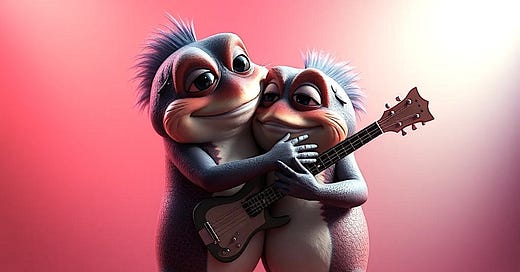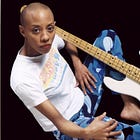Bass Players Need Love Too!
Celebrating some classic performances on an under-appreciated instrument
Bassists get a raw deal. You can read or listen to hundreds of reviews of rock bands, and I’d estimate less than 20% even mention the bassist. Most of them go on about the singers and guitarists, and to a lesser extent the drummers, but the bassists? They may as well be wallpaper.
This is, of course, absurd. It’s like critiquing a painting and only talking about some of the colors. Or trying to understand a novel while skipping every fourth word.
Maybe it’s due to prejudice held over from grade school band class. The bass player was often the kid who didn’t show a lot of promise on other instruments: “Here, this is easy, you can just play these two notes and keep time.” Sort of the way the big, slow kid was always picked to be the soccer goalie (never mind that goalies actually need fast reflexes) or the catcher.
Until the 1950s, bands that used electric guitars still used stand-up acoustic double-basses—similar to the ones used in jazz. The first commercial electric basses were introduced in 1951 (there had been some earlier models but they were not widely known or adopted). One of the first, and most iconic, models was the Fender Precision Bass, or P-Bass, which was the basis for many of the models that came after.
Here is a look at the evolution of basses through the eyes of Billy Sheehan, considered by many the greatest living rock bassist in the world. He shows off his original P-Bass, heavily modified, and worn from thousands of concerts. It is a delightful interview, full of brushes with some of the other great musicians in rock history—you’ll recognize the names!
The advent of the electric bass had several consequences: First, because it was electronically amplified, the bass was no longer in danger of being drowned out by the guitars. This led inevitably to rock becoming much louder and more instrument-forward. In other words, the bass really opened up the door for rock to rock. Prior to that, rock instrumentation was generally there to support the vocalists (a few instrumental bands like the Ventures being the exception).
Second, being designed like a guitar, it was smaller and much easier to handle than a double bass, meaning there was no longer any barrier to touring with one. Third, since it was fretted, unlike the double bass, learning to play it was much easier. Soon there was a whole generation of electric bassists. As rock music took its modern form in the 1960s, the standard lineup became guitar, bass, drums, keyboards and vocals.
Of course, there are the occasional rock songs without a bass. The very first rock musicians, such as Rosetta Tharpe, Buddy Guy and Chuck Berry, initially played without a bass in the mix, or with a double bass. Prince wrote songs without a bass. But those were designed not to need one.
The progressive metal band Animals as Leaders has no bassist—but they use 8-string guitars down-tuned to cover the bass range. The point is, most rock is written for some combination of drums, bass and guitars. The thump of the bass is an integral part of why rock rocks!
It is also true that a lot of rock bassists do see their role as little more than keeping time and providing a foundation for the other instruments. Even then, I would argue we should pay more attention to the bassist just because, if they mess up, everything else falls apart. Reliability matters!
Still, there is so much more to aspire to. Great bassists do more than just set the table for the other instruments. They play as co-lead instruments, with a voice of their own. They compose, sometimes on the fly, and can play solo without losing your interest. Jazz musicians intuitively know this—the bass is often one of the lead voices in jazz ensembles.
I’ve picked four songs which I think capture some of the magic that is possible with the bass. Only one of them is a straight up rock song, but they all influenced how rock bassists play even today.
One of the greatest bass performances of all time is Paul McCartney’s line from “Tell Me Why”. I first heard the song when my mom brought home “A Hard Day’s Night”. She said “Everyone is talking about something called ‘Beatles’ so I wanted to see why.” Most of what I had heard before was either classical (my mom’s collection) or American songbook (my dad’s collection). This was certainly neither!
I had no idea how revolutionary the Beatles were, but I knew I loved the album. And “Tell Me Why” was my favorite song. Much later, I would have more context for understanding why, but it came closer than anything I had heard before to making me want to get up and move.
McCartney is not on the face of it a virtuoso bass player, but he is a brilliant composer, and here he wrote a bass line that still floors me after all these years. The style is sometimes called “walking” bass, but this one hops and skips along and has a life of its own. It is like a song within a song:
*****
Just a year after “Tell Me Why”, another song came out that would feature an unforgettable walking bass line. This was the instrumental “A Taste of Honey”, the opening number on Herb Alpert’s debut album “Whipped Cream and Other Delights”.
Here, Carol Kaye, best known as a member of the Wrecking Crew, opts for a pick and creates a driving bass part that, frankly, makes the song. I think it’s every bit as magical as Sir Paul’s on “Tell Me Why.” The album, in fact, went to #1 on the charts for 1966, ahead of you-know-who.
It was only some years later that I fully came to appreciate the album cover art!
At the other end of the spectrum, we have this minimalist arrangement with bass lead by Jaco Pastorius. Jaco was one of those tortured geniuses whose drug problems and lack of self-control led to a tragic, premature death—in his case, at only 35. In that short time, he became one of the most influential bass guitarists ever. He bridged the worlds of rock and jazz, with the high point being his time with Weather Report.
This is his debut solo recording, a Charlie Parker piece originally played on alto saxophone. Jaco transcribed it for his fretless electric bass, which is itself sort of crazy.
*****
It’s obviously hard to pick among dozens of great musicians, even in a narrow category restricted to one instrument. So I invite you in the comments to suggest your favorite bassists, along with some context. Here is my last pick for this column: Stanley Clarke.
After doing projects with a number of major figures in jazz, including Art Blakey, Stan Getz and Tony Williams, Clarke met Chick Corea, and would join him as a founding member of Return to Forever. I first became immersed in RTF’s music in college, and they became anchors of my life soundtrack for years after.
While still with RTF, Clarke began putting out solo albums, some of them produced by Corea. “School Days” became his biggest album, and the title track is considered one of the key moments in the evolution of electric bass. His use of slapping, pinch harmonics, and electronic effects changed the way rock and fusion bassists have played ever since.
Clarke essentially completed the process of bringing the bass out of the shadows and into its rightful place as a true lead instrument in a full band.
Postscript:
I’ve previously published several articles on women who play bass. Most of them were never given the full recognition they deserve, though some of them have done truly groundbreaking work. Here are five of those pieces, three of them a series about Carol Kaye, who appeared earlier in this article. I hope you find some time to check these musicians out.









This is so helpful as I tend to have trouble picking out the bass, and I always wondered about the walking bass sound I kept reading about.
Just read another post featuring Jaco Pastorius with Joni Mitchell, in case you didn't see it - https://substack.com/home/post/p-162758700?utm_campaign=post&utm_medium=web
Also that Herb Alpert album art! -- https://staciwilson.substack.com/p/the-girl-on-the-album-cover-when-e87